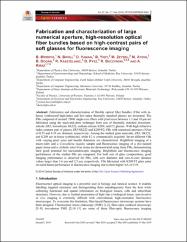Fabrication and Characterization of Large Numerical Aperture, High-Resolution Optical Fiber Bundles Based on High-Contrast Pairs of Soft Glasses for Fluorescence Imaging

Göster/
Erişim
info:eu-repo/semantics/openAccessTarih
2019Yazar
Morova, BernaBavili, Nima
Yaman, Onur
Yiğit, B.
Zeybel, Müjdat
Aydın, Musa
Doğan, B.
Kasztelanic, R.
Pysz, Dariusz
Buczynski, Ryszard
Kiraz, Alper
Üst veri
Tüm öğe kaydını gösterKünye
MOROVA, Berna, Nima BAVİLİ, Onur YAMAN, B. YİĞİT, Müjdat ZEYBEL, Musa AYDIN, B. DOĞAN, R. KASZTELANİC, Dariusz PYSZ, Ryszard BUCZYNSKİ, & Alper KİRAZ. "Fabrication and Characterization of Large Numerical Aperture, High-Resolution Optical Fiber Bundles Based on High-Contrast Pairs of Soft Glasses for Fluorescence Imaging." Optics Express, 27.7 (2019): 9502-9515.Özet
Fabrication and characterization of flexible optical fiber bundles (FBs) with inhouse
synthesized high-index and low-index thermally matched glasses are presented. The
FBs composed of around 15000 single-core fibers with pixel sizes between 1.1 and 10 μm are
fabricated using the stack-and-draw technique from sets of thermally matched zirconiumsilicate
ZR3, borosilicate SK222, sodium-silicate K209, and F2 glasses. With high refractive
index contrast pair of glasses ZR3/SK222 and K209/F2, FBs with numerical apertures (NAs)
of 0.53 and 0.59 are obtained, respectively. Among the studied glass materials, ZR3, SK222,
and K209 are in-house synthesized, while F2 is commercially acquired. Seven different FBs
with varying pixel sizes and bundle diameters are characterized. Brightfield imaging of a
micro-ruler and a Convallaria majalis sample and fluorescence imaging of a dye-stained
paper tissue and a cirrhotic mice liver tissue are demonstrated using these FBs, demonstrating
their good potential for microendoscopic imaging. Brightfield and fluorescence imaging
performance of the studied FBs are compared. For both sets of glass compositions, good
imaging performance is observed for FBs, with core diameter and core-to-core distance
values larger than 1.6 μm and 2.3 μm, respectively. FBs fabricated with K209/F2 glass pairs
revealed better performance in fluorescence imaging due to their higher NA of 0.59.


















